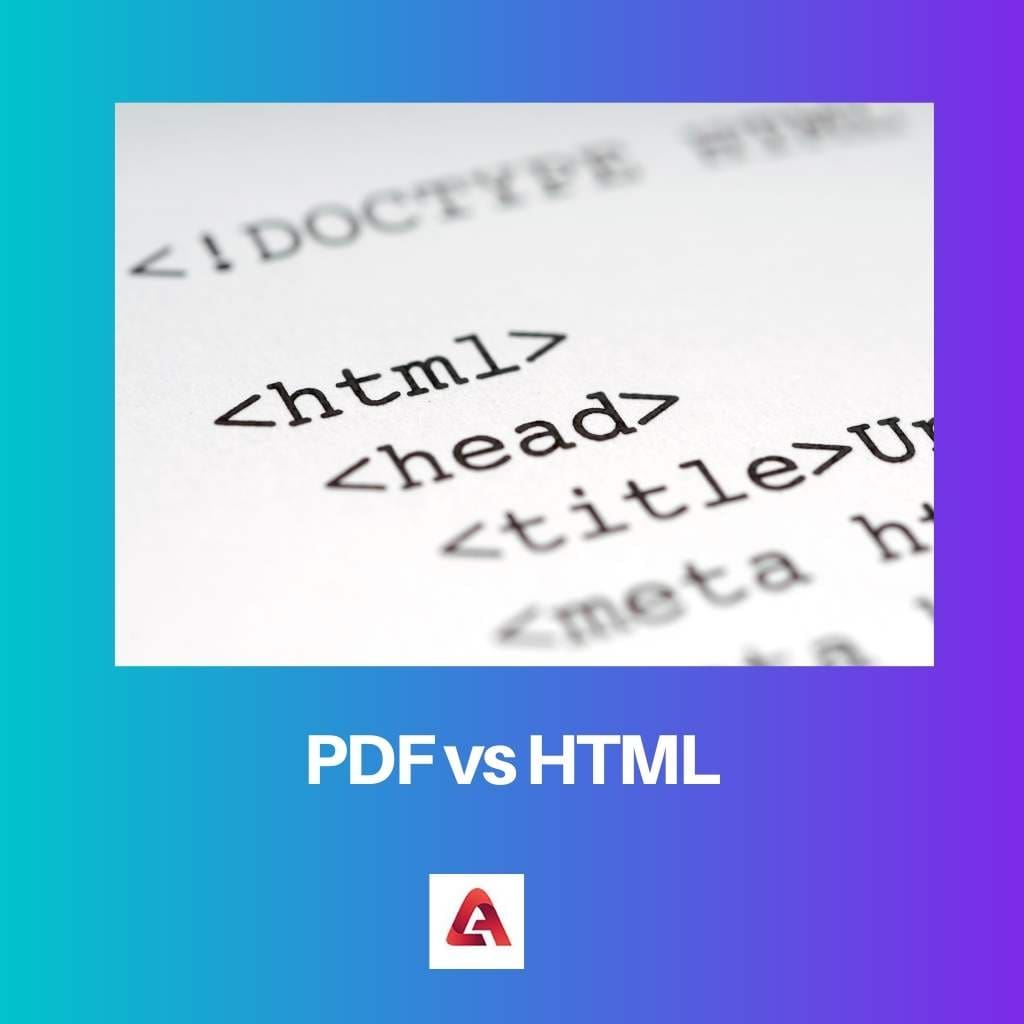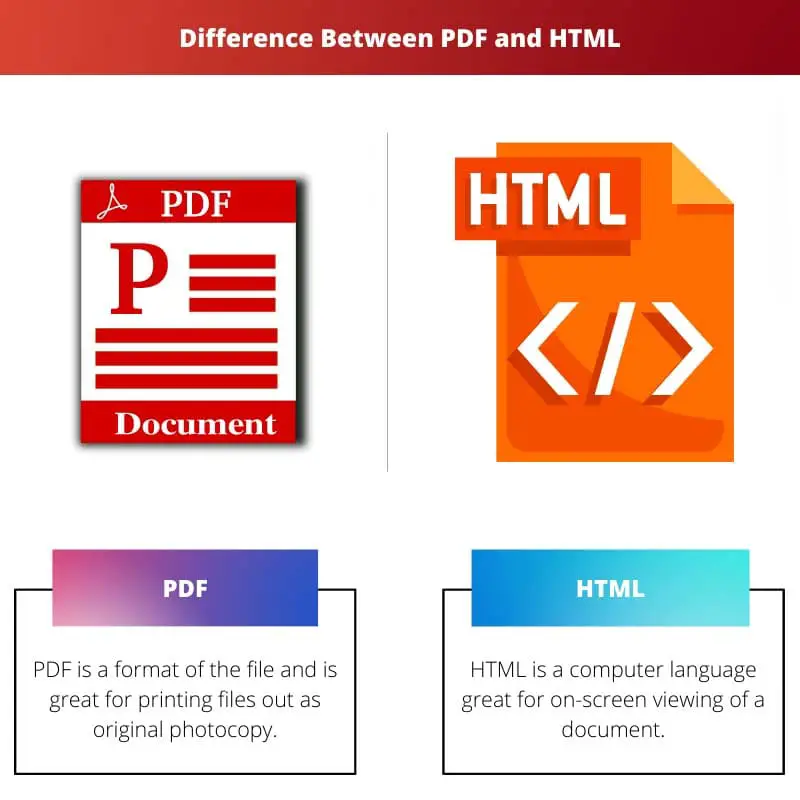PDF stands for Portable Document Format, and HTML stands for HyperText Markup Language. PDF is a document format, while HTML is a computer language.
Key Takeaways
- PDF files are portable document formats designed for sharing and preserving content, whereas HTML is a markup language for creating web pages.
- PDFs maintain consistent formatting across devices, while HTML content may display differently depending on the device and browser.
- PDF files can be password-protected for security, whereas HTML pages are less secure and more susceptible to hacking.
PDF vs HTML
Portable Document Format (PDF) is a non-editable file that can include texts and images in a document format. It is used for sharing and printing files. HTML (Hypertext Markup Language) is a programming language used to display documents in a web browser. It is an editable file for viewing a document.

The full form of PDF is Portable Document Format. The extension of a PDF document is .pdf, and it was initially released around 28 years ago, in 1993.
The full form of HTML is HyperText Markup Language. As it can be derived from the full form itself, HTML is a computer language that is designed to display web documents.
Comparison Table
| Parameters of Comparison | HTML | |
|---|---|---|
| Editing | PDF files are non-editable. | HTML is editable. |
| Category | PDF is a format of the file and is great for printing files out as original photocopy. | HTML is a computer language great for on-screen viewing of a document. |
| Additional Software | PDF requires a PDF viewer to be viewed. | HTML does not need any additional software to be opened. |
| Labor | PDF is much more simple and easier to share. | HTML is very labor-consuming to be made. |
| Utility | PDF is used for sharing all kinds of files in a single file. | HTML is mainly used for uploading web documents. |
What is a PDF?
PDF stands for Portable Document Format. It is a document format containing various elements all at once. The pdf is a non-editable file, which is easy to share.
PDFs may contain various types of files. The files to be mentioned can be vector graphics, text, bitmap graphics, vector graphics for illustrations, and raster graphics for a photograph.
It can be said that the PDF is a much-simplified version of the PostScript language. PostScript is a page description language run in an interpreter to generate an image, a process requiring many resources.
Nowadays, PDF is the most used file format for sharing information. For academic purposes, PDFs were taken the place of books for students, especially in online studies.

What is HTML?
HTML stands for HyperText Markup Language, which is a computer language designed for web purposes. It is great for on-screen viewing but may not be as helpful in printing the whole document accurately.
There are certain building blocks of HTML. Any error in these building blocks will not format the document in the desired way. Every HTML starts with <HTML> and closes with </HTML>.
To view HTML, one does not need any other application because HTML is a computer language itself. HTML documents make it hard to deliver hard copies.

Main Differences Between PDF and HTML
- PDf is not for the web browser. HTML works great for the web. INfact HTML is used for uploading web documents in a browse4r from a server.
- PDFs are mostly read-only files when shared, whereas HTML is editable.

- https://d1wqtxts1xzle7.cloudfront.net/3237835/PDFViewer_Report.pdf?response-content-disposition=inline%3B+filename%3DPDF_to_HTML_Converter.pdf&Expires=1630789250&Signature=Anm6uMHF8CavNmFID5HrkEka1fRQrfIq-424qeiRlOa5~H-8qBTA03fwox75NWPQ9EV73PsZKXSMVrpJu2z6ZknlcYKZglQCLH8srLr9bZpo-VCJnKHiD4373Z33grcn7g5RaSa9LVBSz3-QtC314EbMzjGREhzzlWAGyLKtLr9NfXYNo~acOzGDbKZfFYFFsjkWVjqQFOSLiYIWyrjNy0H08ErN13pNOBPGQ4Q7p3NtftUE~KzXEnoLB7BVtN5Q3GZyZd~ZJZVWXagBP5U4RQfTPdFdZC-2wvwTY-4XGM1M-kIxx106D1dfTRSAT32kLfaegppR-EnXH~3yR3w-DQ__&Key-Pair-Id=APKAJLOHF5GGSLRBV4ZA
- https://www.lexjansen.com/mwsug/2014/SS/MWSUG-2014-SS03.pdf

I find it quite amusing that HTML ‘does not need any additional software to be opened.’ in the context of this discussion.
The irony is not lost, indeed. However, the emphasis is on the distinct features and purposes of each format, which is well presented.
Yes, the statement is ironic given the complexity of web development. Nevertheless, the overall comparison is very clear and insightful.
I wonder what would be the best option for academic use, given the discussion about the security and sharing issues of both formats.
It’s true that the discussion about academic use is important. Both formats have pros and cons. It depends on the specific needs and security requirements.
Yes, maybe combining both formats or using them according to each situation might be the best approach for academic purposes.
The comparison table at the end is very useful for summarizing the characteristics of PDF and HTML. It’s a great way to highlight the contrasts.
Indeed, the table nicely captures the essential contrasts between PDF and HTML in a concise way. It’s a great addition to the article.
Absolutely, the tabular comparison provides a quick and clear overview of the main differences, which is really helpful.
Although the comparison is really well done, I would have liked to see some examples to better illustrate when to use each format.
I agree. Real-life scenarios showing the applications of PDF and HTML might help in understanding their roles better.
That’s a valid point. Incorporating some usage examples could make the comparison even more insightful.
I think PDFs have a clear advantage when it comes to reliability and consistency of formatting, while HTML is more flexible for web content.
You’re right. The comparison made with the parameters helps to see the contrasts. I agree with the distinction between them.
In my opinion, PDF and HTML are complementary formats. Each one has strengths that make them useful in different contexts.
Very interesting and complete comparison between PDF and HTML. It’s good to know the differences between them, each one has its own purposes.
Absolutely, this article illustrates very well the distinctive features of PDF and HTML, it’s very enlightening.
Yes, having a clear understanding of PDF and HTML formats is really important, and this text explains it very well.
I appreciate the precision in the explanation of the different elements and features of PDF and HTML.
Indeed, the details are quite thorough and helpful. The description of the building blocks of HTML in particular provides a good understanding.
The content is really informative, and it’s good to have a clear understanding of the main differences between these two formats.
Yes, I agree. The detailed comparison provides a comprehensive view of the characteristics and uses of PDF and HTML.